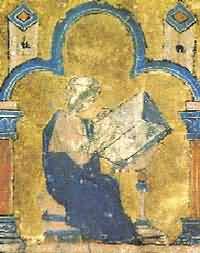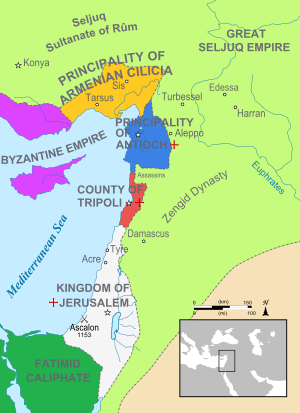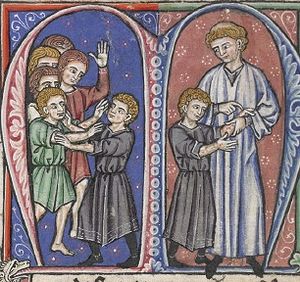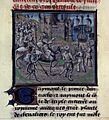William of Tyre facts for kids
Quick facts for kids William of Tyre |
|
|---|---|
| Archbishop of Tyre | |

William of Tyre writing his history, from a 13th-century Old French translation, Bibliothèque Nationale, Paris, MS 2631, f.1r
|
|
| Elected | 6 June 1175 |
| Reign ended | 29 September 1186 |
| Predecessor | Frederick de la Roche |
| Successor | Joscius, Archbishop of Tyre |
| Personal details | |
| Born | 1130 Jerusalem, Kingdom of Jerusalem |
| Died | 29 September 1186 (aged 55–56) Tyre, Kingdom of Jerusalem |
| Denomination | Roman Catholicism |
| Occupation | Medieval chronicler, chancellor |
William of Tyre was an important medieval leader and historian. He was born around 1130 in Jerusalem, which was then the capital of the Kingdom of Jerusalem. This kingdom was set up by Christian crusaders after the First Crusade in 1099.
William spent 20 years studying in Europe, learning about many subjects like history, law, and religion. When he returned to Jerusalem, he became a trusted advisor to King Amalric. He even taught the king's son, Baldwin IV. William later became the Archbishop of Tyre and the kingdom's chancellor, which were very important jobs.
William is most famous for writing a detailed history of the Kingdom of Jerusalem. This book is a key source for understanding the Crusades and the Christian states in the Middle East. Even though he had his own opinions, his work is still considered one of the best historical writings from the Middle Ages. He died in 1186.
Contents
Early Life and Education
The Kingdom of Jerusalem was founded in 1099. It was one of several Christian states created by crusaders in the Middle East. These states included the County of Edessa, the Principality of Antioch, and the County of Tripoli. The early rulers of Jerusalem helped make the kingdom strong and expand its borders. Its territory was similar to modern-day Israel, Palestine, and Lebanon. Many pilgrims visited the holy sites, and merchants came for trade.
William's family likely came from France or Italy. They were probably merchants who had moved to Jerusalem and were quite well-off. William was born in Jerusalem around 1130. He had a brother named Ralph, who was a leader in the merchant community.
As a child, William went to school at the Church of the Holy Sepulchre in Jerusalem. His teacher, John the Pisan, taught him to read and write in Latin. William also knew French and possibly Italian.
Around 1145, William traveled to Europe to continue his studies. He went to famous schools in Paris and Bologna, which were major learning centers at the time. These schools were not yet formal universities, but they had many excellent teachers. William studied liberal arts and theology in Paris and Orléans for about ten years. He learned from some of the most respected scholars of his time. He also studied civil law and canon law (church law) in Bologna. William's education was as good as any church leader in Europe.
Life in Jerusalem
When William returned to Jerusalem in 1165, he quickly rose to important positions. This was unusual because most high-ranking officials were Europeans who had just arrived. William was one of the few local people with a European education. He became a church official in Acre and then archdeacon of Tyre.
King Amalric became king in 1164. He wanted to conquer Egypt, which was ruled by the weak Fatimid Caliphate. However, a powerful Muslim leader named Nur ad-Din Zangi also wanted Egypt. In 1168, King Amalric sent William as an ambassador to the Byzantine Empire. William helped arrange a plan for the Byzantine navy to help the crusaders attack Egypt. However, the plan did not fully succeed, and a general named Saladin eventually took control of Egypt. Saladin would later become a major threat to Jerusalem.
In 1170, King Amalric asked William to write a history of the kingdom. William also became the tutor to Amalric's son, Baldwin IV. One day, when Baldwin was 13, William noticed something worrying. Baldwin was playing with other boys who were scratching each other's arms. The other boys cried out in pain, but Baldwin felt nothing. William realized this could be a sign of leprosy, a serious disease. Sadly, this was confirmed as Baldwin grew older.
When King Amalric died in 1174, Baldwin IV became king. Because Baldwin had leprosy, he could not have children and was not expected to rule for long. This led to political struggles in the kingdom. William was allied with Raymond III of Tripoli, a powerful noble. Raymond appointed William as chancellor of Jerusalem and, in 1175, William was elected Archbishop of Tyre.
In 1179, William was one of the representatives from Jerusalem at the Third Council of the Lateran in Rome. This was an important meeting of church leaders. William also went on diplomatic missions to the Byzantine Emperor. He returned to Jerusalem in 1180.
Political Challenges and Death
While William was away, political tensions grew in Jerusalem. King Baldwin IV needed an heir. His sister, Sibylla, was a widow. Raymond III and his cousin wanted Sibylla to marry Baldwin of Ibelin. However, King Baldwin and his mother, Agnes of Courtenay, arranged for Sibylla to marry a newcomer named Guy of Lusignan. This deepened the divide between the different groups in the kingdom.
William was affected by these changes because he was allied with Raymond. When the Patriarch of Jerusalem died in 1180, William was a strong candidate to replace him. However, Heraclius, who was supported by Agnes of Courtenay, was chosen instead. This was a big disappointment for William.
William remained Archbishop of Tyre and chancellor, but his political influence decreased. He continued to write his history book. He probably died in 1186.
William's fears for his country came true soon after his death. In 1187, Saladin defeated King Guy at the Battle of Hattin. Saladin then captured Jerusalem and most of the kingdom's cities. Only Tyre, William's archdiocese, remained. News of Jerusalem's fall shocked Europe and led to the Third Crusade.
William's Writings
William's most important work is his Latin history book, often called Historia rerum in partibus transmarinis gestarum ("History of Deeds Done Beyond the Sea") or Historia Ierosolimitana ("History of Jerusalem"). He wrote it between 1170 and 1184. The book has 23 parts. It starts with the Muslim conquest of Syria in the 600s, but mostly focuses on the First Crusade and the history of the Kingdom of Jerusalem.
William used many sources for his history. He read earlier chronicles of the First Crusade and other documents from the kingdom's archives. For events that happened in his own lifetime, he talked to older people who had seen them and used his own memories.
William had an excellent education, which helped him write in very good Latin. He used many ideas and quotes from ancient Roman and early Christian writers. His writing style was advanced for his time.
Themes and Biases
William's history is sometimes called "secular" because he did not always focus on God's direct involvement in events. However, he did include many legends, especially about the First Crusade. For example, he made Peter the Hermit seem more important in starting the crusade than he probably was. He also presented Godfrey of Bouillon, the first ruler of Jerusalem, as a legendary hero with great strength and virtue. This shows how much the first crusaders were admired in William's time.
William gave a more balanced view of the kings of his own time. He said King Amalric asked him to write the history. William praised Amalric's education and interest in history, but also noted that the king did not always respect the church.

William greatly admired King Baldwin IV, especially because Baldwin bravely led military campaigns despite his serious illness. William's history can be seen as a defense of Baldwin's rule and the kingdom itself.
William was known for his strong opinions against the Knights Templar. He thought they were too proud and did not respect the rules of the church or the government. He accused them of causing problems in battles and even of murder.
William was surprisingly fair to the Byzantine Empire compared to other Western writers. He had visited the Byzantine court and knew a lot about them. He admired some Byzantine emperors, even though he was disappointed when they couldn't help Jerusalem against the Muslims.
As a Christian writer, William was naturally against the Muslim neighbors of the kingdom. However, because he lived among Muslims, he was often fair in his descriptions. He did not think Muslims were pagans, but rather that they followed a different religion. He even praised some Muslim leaders like Nur ad-Din Zangi and Saladin, calling them honorable and religious men. This was rare for a Christian writer of his time.
How the Historia Spread
After William's death, his history book was copied and shared in the crusader states and in Europe. There are only ten known copies of the original Latin book. However, a French translation, made around 1223, became very popular. There are at least 59 copies of this French version. It was even translated into Spanish and later back into Latin by someone who didn't know a Latin original already existed! An English translation was made in the 1400s.
Other Works
William also wrote a history of the Third Council of the Lateran, but this book has been lost. He also wrote a history of the Holy Land from the time of Muhammad, which is also lost today.
Why William of Tyre is Important Today
For a long time, historians thought William was a completely neutral writer. However, more recent studies show that he did have his own biases, especially when writing about the events of the 1170s and 1180s. For example, his portrayal of Baldwin IV as a hero was partly to support his own political group.
One known weakness in William's history is that he sometimes got dates wrong, even for important events like when kings died.
Despite his biases and occasional errors, William is still considered one of the greatest medieval writers. Historians praise his broad understanding of events and his ability to see cause and effect in history. He is often called "the historian's historian" and "the greatest crusade historian of all." His skill in gathering and evaluating sources, and writing a detailed history in excellent Latin, makes him an outstanding historian for his time.
Images for kids
See also
 In Spanish: Guillermo de Tiro para niños
In Spanish: Guillermo de Tiro para niños




